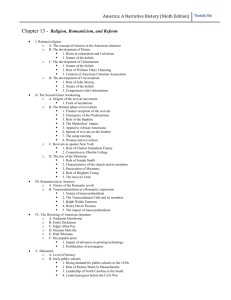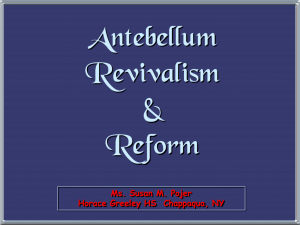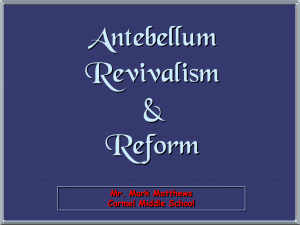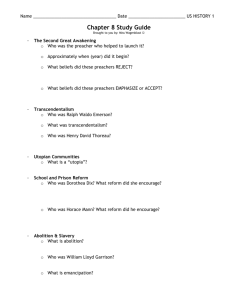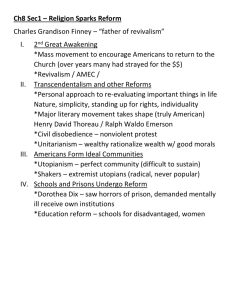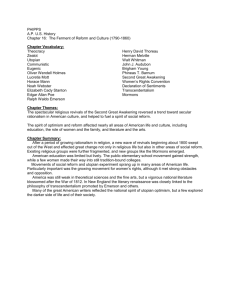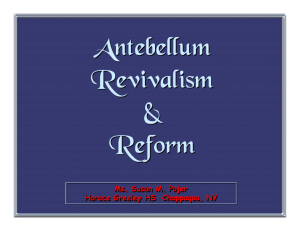Antebellum Reform Movements
advertisement
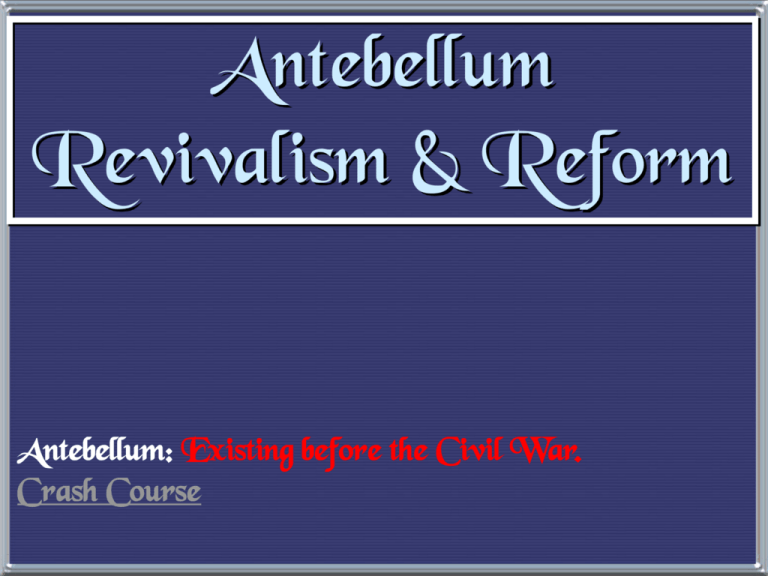
Antebellum Revivalism & Reform Antebellum: Existing before the Civil War. Crash Course T he Second Great Awakening “Spiritual Reform From Within” (Religious Revivalism) Social Reforms & Redefining the Ideal of Equality Temperance Education Abolitionism Asylum & Prison Women’s Rights T he Rise of Popular Religion In France, I had almost always seen the spirit of religion and the spirit of freedom pursuing courses diametrically opposed to each other; but in America, I found that they were intimately united, and that they reigned in common over the same country… Religion was the foremost of the political institutions of the United States. -- Alexis de Tocqueville, 1832 Alexis de Tocqueville T he Rise of Popular Religion • The religion of these years is not the religion of colonial era. • The Calvinist rigor had been seeping out of churches. • Deism= Relying on reason rather than revelation. On science, rather than the Bible. • Promoted by T. Paine, Jefferson, and Franklin • They reject the concept of original sin. • Deny God’s divinity. • Believe in a Supreme Being who created a knowable universe and endowed humans with a capacity of morality. T he Rise of Popular Religion • Unitarians- God exists in only one person, no trinity. • Spinoff of Deism • Gathered momentum in New England states • Stress the essential goodness of human nature rather than bad • Proclaim their belief in free will • Possibility of salvation through good works. • God is not a stern Creator, but rather a loving Father. • Embraced by Ralph Waldo Emerson • Appealed mostly to intellectuals, rationalists • Opposed the Calvinist concepts of predestination and human depravity. “T he Pursuit of Perfection” In Antebellum America “T he Benevolent Empire”: 1825 - 1846 “T he Benevolent Empire”: 1825 - 1846 • Various Protestant denominations developed missionary organizations in order to “Christianize” citizens not only in the U.S. but all over the world. • The goal was to create and maintain a Christian nation. • Started by wealthy and middle-class who lived in cities. T he “Burned-Over” District in Upstate New York • Like the 1st GA, the 2nd GA tended to widen lines between classes and regions. Feminization of Religion • Middle-class women (wives and daughters of businessmen) • Most fervent enthusiasts of revivalism. • Made up the majority of new church membership. • Mostly likely to ‘stay with the fold’ when revivals ended. • Revivalists sometimes preached of female spiritual worth and offered women an active role in bringing their husbands and families back to God. Denominational Diversity • Eastern denominations that were already more prosperous and conservative were not that effected by revivalism. • Episcopalians, Presbyterians, Congregationalists, and Unitarians continued to rise from the wealthier, bettereducated members of society. • Methodists and Baptists tended to come from less prosperous, less educated communities in the rural South and West. Denominational Diversity • Issue of slavery • Southern Baptists and Methodists had split with the Northern sect over the issue. • Presbyterians parted ways along North/South line. • The secession of the southern churches foreshadowed the secession of the southern states. • First the churches, then the political parties, then the country. T he “Burned-Over” District in Upstate New York • Mostly in Western New York • Descendants of New England Puritans • Many sermons preaching “hellfire and damnation” • Adventists interpreted the Bible to mean that Christ would return to earth on Oct. 22, 1844. • They gather together in prayer, wearing their church clothes to greet God. • Failure of this meeting led to decline, but not elimination. Second Great Awakening Revival Meeting Charles G. Finney (1792 – 1895) “soul-shaking” conversion The ranges of tents, the fires, reflecting light…; the candles and lamps illuminating the encampment; hundreds moving to and fro…;the preaching, praying, singing, and shouting,… like the sound of many waters, was enough to swallow up all the powers of contemplation. T he Mormons (The Church of Jesus Christ of Latter-Day Saints) • Joseph Smith receives golden plates from an angel. • When deciphered, the constituted the BOM. • Smith ran into opposition in OH, MO, and IL. • They angered people by tending to vote as a unit (anti-individualism). • Accusations of polygamy. Joseph Smith (1805-1844) • Smith and his brother are murdered in 1844. • Things You Don't Know About: Mormons (History Channel) T he Desert Zion in Utah • Brigham Young takes over and moves Mormons to UT. • Young had 27 wives, 56 children. • Established a missionary movement. • Federal Army marched against them in 1857 fearing lack of control over group. • Antipolygamy laws passed in 1862, 1882. Delayed statehood until 1896. Violence A gainst Mormons T he Mormon “Trek” Utopian Communities Utopian Communities • Set up by various people/groups. From high minded to lunatics. • More than 40 communities of a cooperative, communitarian nature. • They sought human betterment. T he Oneida Community New York, 1848 • Practiced “free love”, birth control, and eugenics. • Flourished for 30+ years due to artisans making silver products. John Humphrey Noyes (1811-1886) Original Plans for New Harmony, IN New Harmony in 1832 New Harmony, IN • Wealthy, idealistic Scottish textile manufacturer. • 1,000 people • Not much harmony due to radicals, lazy theorists, crooks. • Most were hard-working visionaries. • Declined due to contradiction and confusion. Robert Owen Secular Utopian Communities Individual Freedom Demands of Community Life Spontaneity Discipline Self-fulfillment Organizational hierarchy George Ripley (1802-1880) Brook Farm West Roxbury, MA • 200 acres of farm land • Started by about 20 intellectuals committed to philosophy of transcendentalism. • Promoted “plain living and high thinking” • Prospered until 1846. • Lost a large communal building due to fire. • Consumed by debt. • Inspired a book: The Blithedale Romance written by Hawthorne. Mother Ann Lee (1736-1784) T he Shakers If you will take up your crosses against the works of generations, and follow Christ in the regeneration, God will cleanse you from all unrighteousness. Remember the cries of those who are in need and trouble, that when you are in trouble, God may hear your cries. If you improve in one talent, God will give you more. • One of the longest-living sects. • Founded in 1747 in England. • Brought to American in 1774 by Mother Ann Lee. • Settled in upstate New York. • Membership of about 6,000 since 1840. • Virtually extinct by 1940 due to prohibition of marriage and sex. Shaker Hymn 'Tis the gift to be simple, 'Tis the gift to be free, 'Tis the gift to come down where you ought to be, And when we find ourselves in the place just right, 'Twill be in the valley of love and delight. When true simplicity is gained To bow and to bend we shan't be ashamed, To turn, turn will be our delight, 'Till by turning, turning we come round right. Shaker Simplicity & Utility Transcendentalism (European Romanticism) Liberation from understanding and the cultivation of reasoning.” “Transcend” the limits of intellect and allow the emotions, the SOUL, to create an original relationship with the Universe. Transcendentalist T hinking Man must acknowledge a body of moral truths that were intuitive and must TRANSCEND more sensational proof: • The infinite benevolence of God. • The infinite benevolence of nature. • The divinity of man. They instinctively rejected all secular authority and the authority of organized churches and the Scriptures, of law, or of conventions Transcendentalism (European Romanticism) Therefore, if man was divine, it would be wicked that he should be held in slavery, or his soul corrupted by superstition, or his mind clouded by ignorance!! Thus, the role of the reformer was to restore man to that divinity which God had endowed them. Transcendentalist Intellectuals/Writers Concord, M A Ralph Waldo Emerson Nature (1832) Henry David Thoreau Self-Reliance (1841) “The American Scholar” (1837) Walden (1854) Resistance to Civil Disobedience (1849) T he Transcendentalist A genda Give freedom to the slave. Give well-being to the poor and the miserable. Give learning to the ignorant. Give health to the sick. Give peace and justice to society. A Transcendentalist Critic: Nathaniel Hawthorne (1804-1864) Their pursuit of the ideal led to a distorted view of human nature and possibilities: * The Blithedale Romance One should accept the world as an imperfect place: * Scarlet Letter * House of the Seven Gables Penitentiary Reform Dorothea Dix (1802-1887) 1821 first penitentiary founded in Auburn, NY Dorothea Dix Asylum - 1849 Temperance Movement 1826 - American Temperance Society “Demon Rum”! Frances Willard The Beecher Family Annual Consumption of Alcohol “T he Drunkard’s Progress” From the first glass to the grave, 1846 Social Reform Prostitution T he “Fallen Woman” Sarah Ingraham (1802-1887) 1835 Advocate of Moral Reform Female Moral Reform Society focused on the “Johns” & pimps, not the girls. Educational Reform Religious Training Secular Education MA always on the forefront of public educational reform * 1st state to establish tax support for local public schools. By 1860 every state offered free public education to whites. * US had one of the highest literacy rates. Horace Mann (1796-1859) “Father of American Education” children were clay in the hands of teachers and school officials children should be “molded” into a state of perfection discouraged corporal punishment established state teacher- training programs T he McGuffey Eclectic Readers Used religious parables to teach “American values.” Teach middle class morality and respect for order. Teach “3 Rs” + “Protestant ethic” (frugality, hard work, sobriety) Women Educators Troy, NY Female Seminary curriculum: math, physics, history, geography. train female teachers Emma Willard (1787-1870) 1837 she established Mt. Holyoke (So. Hadley, MA) as the first college for women. Mary Lyons (1797-1849) A Female Seminary “Separate Spheres” Concept “Cult of Domesticity” A woman’s “sphere” was in the home (it was a refuge from the cruel world outside). Her role was to “civilize” her husband and family. An 1830s MA minister: The power of woman is her dependence. A woman who gives up that dependence on man to become a reformer yields the power God has given her for her protection, and her character becomes unnatural! Early 19c Women 1. 2. 3. 4. Unable to vote. Legal status of a minor. Single could own her own property. Married no control over her property or her children. 5. Could not initiate divorce. 6. Couldn’t make wills, sign a contract, or bring suit in court without her husband’s permission. W hat It Would Be Like If Ladies Had T heir Own Way! Cult of Domesticity = Slavery The 2nd Great Awakening inspired women to improve society. Sarah Grimké Angelina Grimké Southern Abolitionists Lucy Stone American Women’s Suffrage Assoc. edited Woman’s Journal Women’s Rights 1840 split in the abolitionist movement over women’s role in it. London World Anti-Slavery Convention Lucretia Mott Elizabeth Cady Stanton 1848 Seneca Falls Declaration of Sentiments Seneca Falls Declaration Abolitionist Movement 1816 American Colonization Society created (gradual, voluntary emancipation. British Colonization Society symbol Abolitionist Movement Create a free slave state in Liberia, West Africa. No real anti-slavery sentiment in the North in the 1820s & 1830s. Gradualists Immediatists Anti-Slavery Alphabet W illiam Lloyd Garrison (1801-1879) Slavery & Masonry undermined republican values. Immediate emancipation with NO compensation. Slavery was a moral, not an economic issue. T he Liberator Premiere issue January 1, 1831 T he Tree of Slavery—Loaded with the Sum of All Villanies! Other W hite Abolitionists Lewis Tappan James Birney Arthur Tappan Liberty Party Ran for President in 1840 & 1844. Black Abolitionists David Walker (1785-1830) 1829 Appeal to the Coloured Citizens of the World Fight for freedom rather than wait to be set free by whites. Frederick Douglass (1817-1895) 1845 The Narrative of the Life Of Frederick Douglass 1847 “The North Star” Sojourner Truth (1787-1883) or Isabella Baumfree 1850 The Narrative of Sojourner Truth Harriet Tubman (1820-1913) Helped over 300 slaves to freedom. $40,000 bounty on her head. Served as a Union spy during the Civil War. “Moses” Leading Escaping Slaves Along the Underground Railroad T he Underground Railroad T he Underground Railroad “Conductor” ==== leader of the escape “Passengers” ==== escaping slaves “Tracks” ==== routes “Trains” ==== farm wagons transporting the escaping slaves “Depots” ==== safe houses to rest/sleep
